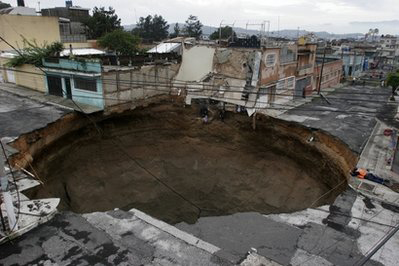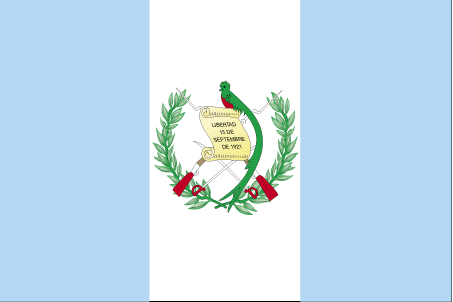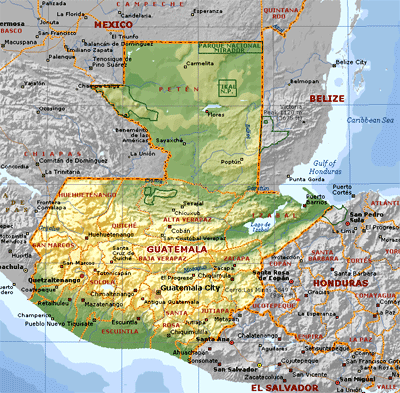|
Three vertical bands of light blue, white, and light blue with a coat
of arms in the center ; the coat of arms has a green and red quetzal (sacred Mayan bird) and a scroll with the
words “Libertad 15 de septiembre de 1821" on crossed rifles and crossed
swords both framed by a green wreath. |
|
Official name: República de Guatemala; etymology:
Capital:
National bird: Quetzal
Government: constitutional democratic republic
Independence
day: 15 de septiembre 1821
President:
President Alvaro Colom Caballeros (4 year term)
Legislature:
Congreso de la República (unicameral)
Political parties: 14; president’s party: GANA (alliance of small parties)
Life expectancy: men, 68; women, 72
Literacy: 70%
Money: Quetzal (8.2 / $1.0 US)
Internet code: .gt
Internet users: 450,000 (2004); 800,000 (2007)
Population:
13,500,000 (2010)
Birth rate: 5 times the death rate
Below poverty line: 75%
Mestizo: 60% (called “ladino” in
K'iche 9.1%, (“quiché” in Spanish)
Kaqchikel 8.4%,
Mam 7.9%,
Q'eqchi 6.3%
Other Mayan 8.6%
Other 0.1%
Languages:
Spanish 60%,
Amerindian languages 40%:
23 Amerindian languages (Quiche, Cakchiquel, Kekchi, Mam, Garifuna, Xinca)
Religions:
Roman Catholic: 75%
Evangelical Protestant: 20%
Indigenous Mayan beliefs: 5%
History:
2,000 B.C.E. – 1,000 C.E.
Maya civilization
in
1,000 Collapse of Mayan empire for unknown reasons.
1485 (c.)-1541 Pedro de Alvarado.
1524 Conquest of
1521
– 1821 Spanish colony of Capitanía General de Goatemala
(southern
1523 – 1527 Alvarado led the Spanish conquest of
1525 - 1541 Alvarado was governor of
1541 Alvarado,
one of the most brutal of all Spanish conquistadors, died when he was crushing
during a mudslide from the Antigua volcano Agua (agua means water; see: => Antigua #6).
He was first buried in
1543
– 1773 Capital settled at
1697 Final defeat of the last unconquered Mayas at Lake Petén Itzá (see upper center on map above) or, alternatively, final victory (?) of the Spanish colonial forces.
1773 Capital moved to
1821 Guatemalan independence (accompanying Mexican independence)
1822
– 1840
1840
1899
– 1974 Miguel Angel Asturias (
1925
1931 – 1944 Jorge Ubico, dictador
United Fruit Company controls 42% of Guatemalan land
1946 El señor presidente (novel by Miguel Angel Asturias). For pasages from this novel, see: => El señor presidente.
1949 Hombres de maíz (early novel by
1951
– 1954 Jacobo Arbenz Guzmán (1913
– 1971): first president under
universal suffrage; overthrown by CIA golpe
de estado
1960 – 1996 Guerrilla war: 100,000 dead; 1,000,000 refugees; period of death squads
1982 – 1983 Gen. Efraín Ríos Montt, dictator
1985 Current constitution adopted
1991
1992 Rigoberta Menchú wins Nobel Peace Prize (indigenous human rights activist)
1996 Peace agreement ending the conflict (100,000 dead, 1 million refugees)
2004 Oscar Berger Perdomo elected president.
2008 Álvaro Colom Caballeros elected president.
2010 (May) First Tropical storm of 2010 hurricante
season (Agatha) causes more than 150 deaths and a giant sinkhole in downtown
Guatemala City; Reuters’ photo:
 |
Geography:
Size of Tennessee
Borders with:
Climate: hot, humid near coasts; cooler in mountains; tropical rain forest at Petén
Highest peak: Volcán Tajomulco (4,200 m.)
Natural resources: petroleum, wood, fish, coffee, sugar, bananas
Natural hazards: earthquakes and hurricanes
Literature:
Popol Vuh (sacred book of the Mayas)
Anales de los Kakchiqueles (Kakchiquel book)
Chilam Balam (Mayan book)
Rigoberta Menchú
Miguel Angel Asturias El señor presidente (novel); Hombres de maíz (early novel in style of
realismo mágico, 1949)



